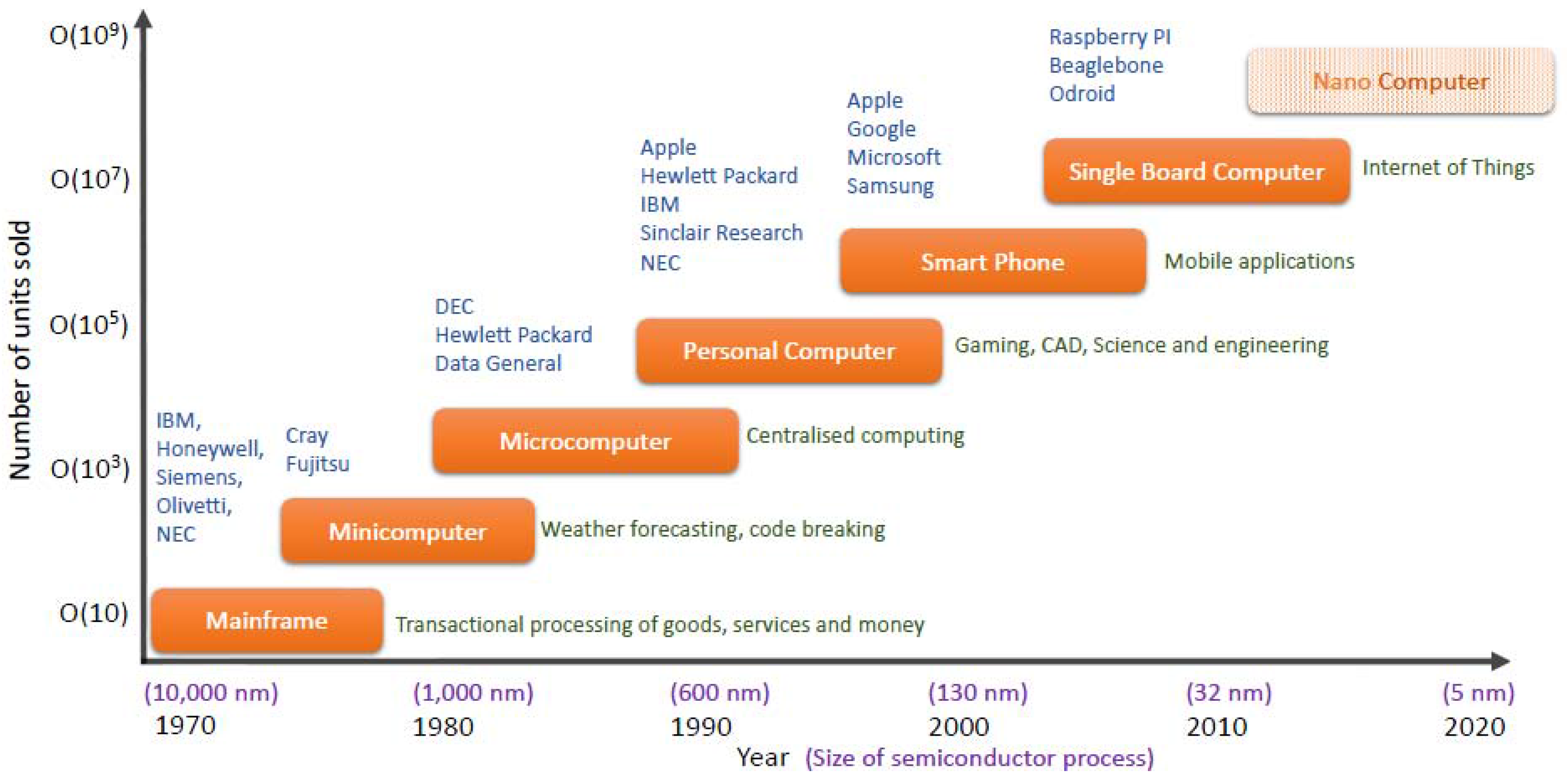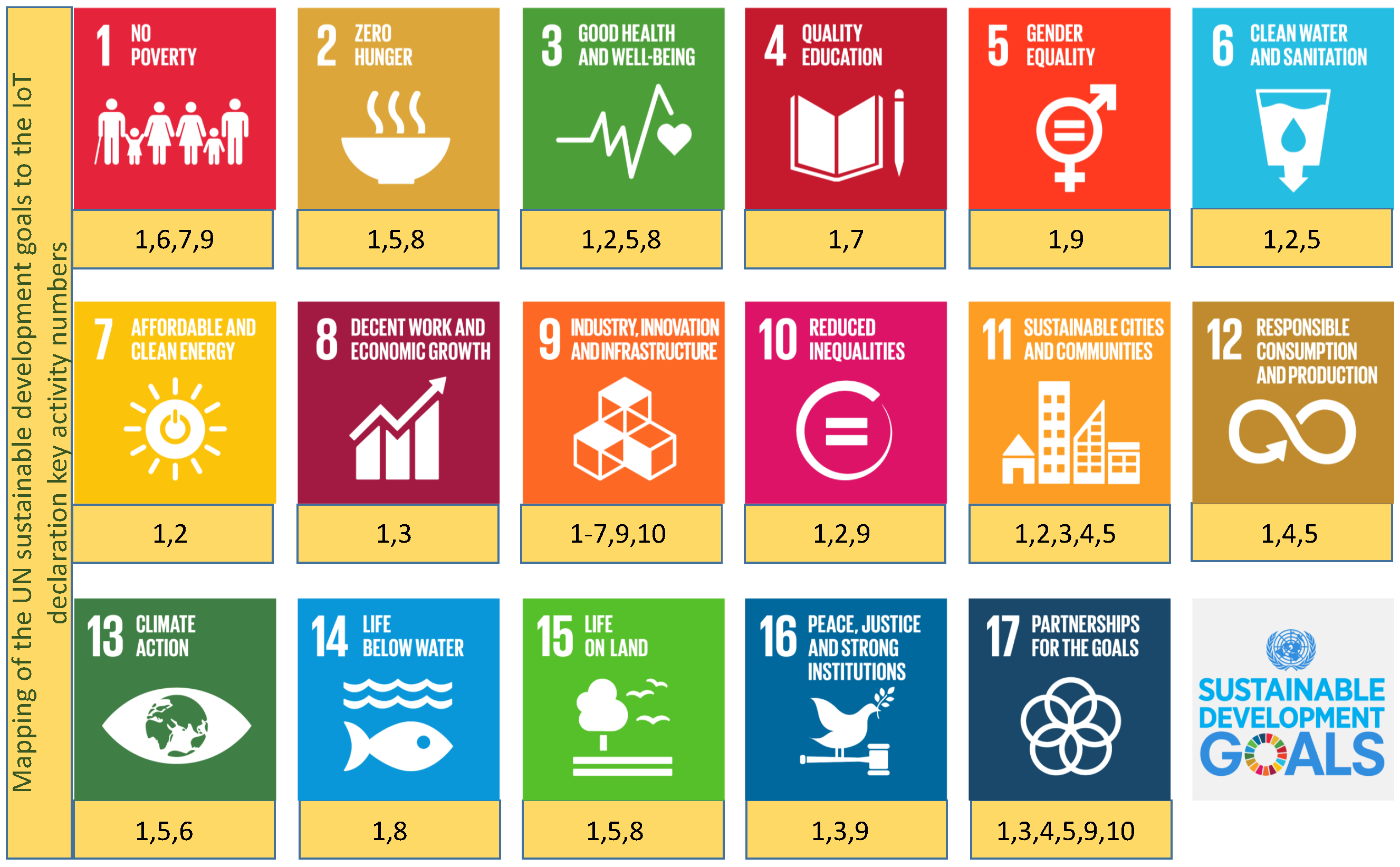The Raspberry Pi: A Technology Disrupter, and the Enabler of Dreams
1. Introduction
2. Special Issue on Raspberry Pi Technology
3. Pi the Prototype
- to test and validate an idea or hypotheses. This follows the fail fast design philosophy where it is best to identify the good and bad ideas early. Building a prototype in a matter of days is acceptable even if it is too big, expensive, consumes too much power and is a bit slow, if it provides a mechanism to prove or disprove the feasibility of an idea.
- to validate hardware design. Before commissioning a large production run or fully optimising a design, a prototype can be used to validate the electronic design and sensor capabilities within a desired operating environment.
4. Pi as the Enabler
5. Pi in the Cloud
6. Pi on the Edge
7. Pi Containers
8. Pi in the Future
- Promoting the development and adoption of IoT technologies for the benefit of humanity, the environment and sustainable development.
- Supporting the implementation of the IoT in urban and rural context to foster the application of ICTs in providing services to build smarter and more sustainable cities and communities .
- Promoting a broad, vibrant and secure ecosystem for IoT, including support for start-ups and incubators.
- Encouraging the development and implementation of standards that facilitate interoperability among IoT technologies and solutions in order to pave the way to an open and interoperable IoT ecosystem
- Adopting new and innovative IoT applications to deal with challenges associated with hunger, water supply, and food security
- Galvanizing interest in the use of IoT for risk reduction and climate change mitigation
- Identifying and supporting the growing trend of using IoT technologies for education
- Embracing the application and use of IoT for biodiversity conservation and ecological monitoring
- Contributing to global research and discussions on IoT for smart and sustainable cities through global initiatives
- Promoting international dialogue and cooperation on IoT for sustainable development
Acknowledgments
Conflicts of Interest
References
- Solomon, L. Sinclair ZX81 personal computer. Pop. Electron. 1982, 20, 32–34. [Google Scholar]
- The MagPi, A magazine for Raspberry Pi users. 2012. Available online: https://www.raspberrypi.org/magpi-issues/MagPi01.pdf (accessed on 10 July 2017).
- Vestberg, H. CEO to Shareholders: 50 Billion Connections 2020. 2010. Available online: https://www.ericsson.com/en/press-releases/2010/4/ceo-to-shareholders-50-billion-connections-2020 (accessed on 27 June 2017).
- Kölling, M. Educational Programming on the Raspberry Pi. Electronics 2016, 5, 33. [Google Scholar] [CrossRef]
- Reck, R.M.; Sreenivas, R.S. Developing an Affordable and Portable Control Systems Laboratory Kit with a Raspberry Pi. Electronics 2016, 5. [Google Scholar] [CrossRef]
- Zhong, X.; Liang, Y. Raspberry Pi: An Effective Vehicle in Teaching the Internet of Things in Computer Science and Engineering. Electronics 2016, 5. [Google Scholar] [CrossRef]
- Hajji, W.; Tso, F.P. Understanding the Performance of Low Power Raspberry Pi Cloud for Big Data. Electronics 2016, 5. [Google Scholar] [CrossRef]
- Semwal, T.; Nair, S.B. AgPi: Agents on Raspberry Pi. Electronics 2016, 5. [Google Scholar] [CrossRef]
- Pahl, C.; Helmer, S.; Miori, L.; Sanin, J.; Lee, B. A Container-Based Edge Cloud PaaS Architecture Based on Raspberry Pi Clusters. In Proceedings of the IEEE 4th International Conference on Future Internet of Things and Cloud Workshops, Vienna, Austria, 22–24 August 2016. [Google Scholar]
- Cloutier, M.F.; Paradis, C.; Weaver, V.M. A Raspberry Pi Cluster Instrumented for Fine-Grained Power Measurement. Electronics 2016, 5. [Google Scholar] [CrossRef]
- Leccese, F.; Cagnetti, M.; Di Pasquale, S.; Giarnetti, S.; Caciotta, M. A New Power Quality Instrument Based on Raspberry-Pi. Electronics 2016, 5. [Google Scholar] [CrossRef]
- Noriega-Linares, J.E.; Navarro Ruiz, J.M. On the Application of the Raspberry Pi as an Advanced Acoustic Sensor Network for Noise Monitoring. Electronics 2016, 5. [Google Scholar] [CrossRef]
- Samourkasidis, A.; Athanasiadis, I.N. A Miniature Data Repository on a Raspberry Pi. Electronics 2017, 6. [Google Scholar] [CrossRef]
- Sørensen, C.W.; Hernández Marcano, N.J.; Cabrera Guerrero, J.A.; Wunderlich, S.; Lucani, D.E.; Fitzek, F.H.P. Easy as Pi: A Network Coding Raspberry Pi Testbed. Electronics 2016, 5. [Google Scholar] [CrossRef]
- Hernández Marcano, N.J.; Sørensen, C.W.; Cabrera, G.J.A.; Wunderlich, S.; Lucani, D.E.; Fitzek, F.H.P. On Goodput and Energy Measurements of Network Coding Schemes in the Raspberry Pi. Electronics 2016, 5. [Google Scholar] [CrossRef]
- Basford, P.J.; Bragg, G.M.; Hare, J.S.; Jewell, M.O.; Martinez, K.; Newman, D.R.; Pau, R.; Smith, A.; Ward, T. Erica the Rhino: A Case Study in Using Raspberry Pi Single Board Computers for Interactive Art. Electronics 2016, 5, 35. [Google Scholar] [CrossRef]
- Schlobohm, J.; Pösch, A.; Reithmeier, E. A Raspberry Pi Based Portable Endoscopic 3D Measurement System. Electronics 2016, 5, 43. [Google Scholar] [CrossRef]
- Coates, J.; Chipperfield, A.; Clough, G. Wearable Multimodal Skin Sensing for the Diabetic Foot. Electronics 2016, 5. [Google Scholar] [CrossRef]
- Virant, M.; Ambrož, M. Universal Safety Distance Alert Device for Road Vehicles. Electronics 2016, 5, 19. [Google Scholar] [CrossRef]
- Calvo, I.; Gil-García, J.M.; Recio, I.; López, A.; Quesada, J. Building IoT Applications with Raspberry Pi and Low Power IQRF Communication Modules. Electronics 2016, 5, 54. [Google Scholar] [CrossRef]
- Jennehag, U.; Forsstrom, S.; Fiordigigli, F.V. Low Delay Video Streaming on the Internet of Things Using Raspberry Pi. Electronics 2016, 5, 60. [Google Scholar] [CrossRef]
- Pasquali, V.; Gualtieri, R.; D’Alessandro, G.; Granberg, M.; Hazlerigg, D.; Cagnetti, M.; Leccese, F. Monitoring and Analyzing of Circadian and Ultradian Locomotor Activity Based on Raspberry-Pi. Electronics 2016, 5. [Google Scholar] [CrossRef]
- Bueti, C. Overview of ITU-T Study Group 20—ToT and its applications including Smart Cities and Communities (SC&C). ITU-T 2013. [Google Scholar]
- Baraniuk, C. Raspberry Pi Passes 10m Sales Mark. 2016. Available online: http://www.bbc.co.uk/news/technology-37305200 (accessed on 27 June 2017).
- PC Extreme. Raspberry Pi Colocation. 2017.
- Stevens, P. Mythic Beasts Ltd - Raspberry Pi Cloud. 2017. Available online: https://www.mythic-beasts.com/ (accessed on 27 June 2017).
- Rajovic, N.; Rico, A.; Puzovic, N.; Adeniyi-Jones, C.; Ramirez, A. Tibidabo11Tibidabo is a mountain overlooking Barcelona.: Making the case for an ARM-based HPC system. Futur. Gener. Comput. Syst. 2014, 36, 322–334, Special Section: Intelligent Big Data Processing Special Section: Behavior Data Security Issues in Network Information Propagation Special Section: Energy-efficiency in Large Distributed Computing Architectures Special Section: eScience Infrastructure and Applications. [Google Scholar] [CrossRef]
- Woolf, N. No Treat for You: Pets Miss Meals After Auto-Feeding App PetNet Glitches. 2016. Available online: https://www.theguardian.com/technology/2016/jul/27/petnet-auto-feeder-glitch-google (accessed on 27 June 2017).
- Helmer, S.; Pahl, C.; Sanin, J.; Miori, L.; Brocanelli, S.; Cardano, F.; Gadler, D.; Morandini, D.; Piccoli, A.; Salam, S.; et al. Bringing the Cloud to Rural and Remote Areas via Cloudlets. In Proceedings of the 7th Annual Symposium on Computing for Development, Nairobi, Kenya, 18–20 November 2016; p. 14. [Google Scholar]
- Cox, S.J.; Cox, J.T.; Boardman, R.P.; Johnston, S.J.; Scott, M.; O ’Brien, N.S. Iridis-pi: A low-cost, compact demonstration cluster. Clust. Comput. 2013. [Google Scholar] [CrossRef]
- Adams, J.C.; Caswell, J.; Matthews, S.J.; Peck, C.; Shoop, E.; Toth, D.; Wolfer, J. The Micro-Cluster Showcase: 7 Inexpensive Beowulf Clusters for Teaching PDC. In Proceedings of the 47th ACM Technical Symposium on Computing Science Education, Memphis, TN, USA, 2–5 March 2016; pp. 82–83. [Google Scholar]
- Introducing Wee Archie. 2017. Available online: https://www.epcc.ed.ac.uk/blog/2015/11/26/wee-archie (accessed on 25 April 2017).
- Pfalzgraf, A.M.; Driscoll, J.A. A low-cost computer cluster for high-performance computing education. In Proceedings of the 2014 IEEE International Conference on Electro/Information Technology (EIT), Milwaukee, WI, USA, 5–7 June 2014; pp. 362–366. [Google Scholar]
- Kurtzer, G.M.; Sochat, V.; Bauer, M.W. Singularity: Scientific containers for mobility of compute. PLoS ONE 2017, 12, 1–20. [Google Scholar] [CrossRef] [PubMed]
- Docker Inc. 2017. Available online: https://docker.com (accessed on 27 April 2017).
- Singularity 2.1.2—Linux application and environment containers for science. Available online: https://zenodo.org/record/60736#.WXAYr1GW3iB (accessed on 10 July 2017).
- Evans, D. The internet of things: How the next evolution of the internet is changing everything. CISCO White Pap. 2011, 1, 1–11. [Google Scholar]
- Middleton, P.; Kjeldsen, P.; Tully, J. Forecast: The Internet of Things, Worldwide; Gartner: Stanford, CT, USA, 2013; pp. 1–15. [Google Scholar]
- UN. The World at Six Billion. 1999. Available online: http://www.bbc.co.uk/news/technology-37305200 (accessed on 27 June 2017).
- UN. World Population Prospects, Key Findings & Advance Tables; UN: New York, NY, USA, 2017. [Google Scholar]
- Quarter, T. State of the Internet; Security Report. Akamai Technologies. Available online: https://www.akamai.com/us/en/about/news/press/2016-press/akamai-releases-third-quarter-2016-state-of-the-internet-security-report.jsp (accessed on 10 July 2017).
- UN. Transforming Our World: The 2030 Agenda for Sustainable Development; Department of Economic and Social Affairs, UN: New York, NY, USA, 2015. [Google Scholar]
- Internet of Things Declaration to Achieve the Sustainable Development Goals. In Proceedings of the IoT Forum, Geneva, Switzerland, 6–9 June 2017.


© 2017 by the authors. Licensee MDPI, Basel, Switzerland. This article is an open access article distributed under the terms and conditions of the Creative Commons Attribution (CC BY) license (http://creativecommons.org/licenses/by/4.0/).
Share and Cite
Johnston, S.J.; Cox, S.J. The Raspberry Pi: A Technology Disrupter, and the Enabler of Dreams. Electronics 2017, 6, 51. https://doi.org/10.3390/electronics6030051
Johnston SJ, Cox SJ. The Raspberry Pi: A Technology Disrupter, and the Enabler of Dreams. Electronics. 2017; 6(3):51. https://doi.org/10.3390/electronics6030051
Chicago/Turabian StyleJohnston, Steven J, and Simon J Cox. 2017. "The Raspberry Pi: A Technology Disrupter, and the Enabler of Dreams" Electronics 6, no. 3: 51. https://doi.org/10.3390/electronics6030051




